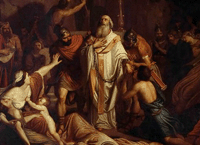
Great Persecution
Emperor Diocletian: Early Life and Rise to Power
Diocletian was born around 244 CE in the Roman province of Dalmatia (modern-day Croatia) to a relatively humble background. His original name was Diocles, and he rose through the military ranks thanks to his competence and loyalty. Following the chaotic period of the Crisis of the Third Century—an era marked by civil wars, economic collapse, and external invasions—Diocles seized power after the assassination of Emperor Numerian in 284 CE. Upon becoming emperor, he Latinized his name to Gaius Aurelius Valerius Diocletianus.
Reforms and the Tetrarchy
Diocletian is best known for his ambitious and wide-reaching reforms designed to stabilize and strengthen the empire. Recognizing that the Roman Empire had grown too vast for a single ruler to manage, he established the Tetrarchy in 293 CE. This system divided the empire into two halves:
- Eastern Empire: Ruled by Diocletian (Augustus) and Galerius (Caesar)
- Western Empire: Ruled by Maximian (Augustus) and Constantius Chlorus (Caesar)
Each Augustus was the senior emperor, and each Caesar was the designated successor. This system was intended to provide smooth transitions of power and more efficient governance.
Military and Administrative Reforms
Diocletian reorganized the Roman military, bolstering frontier defenses and separating civil and military commands to reduce the risk of rebellion. Administratively, he subdivided provinces and grouped them into dioceses, each overseen by a vicarius, which helped improve tax collection and governance. He also reformed the tax system, introducing a new land and head tax (the capitatio-jugatio) that was assessed based on population and productivity. This was a radical shift aimed at stabilizing state revenues.
Economic Policies and the Edict on Maximum Prices
In response to rampant inflation, Diocletian introduced a new coinage system. However, inflation persisted, leading him to issue the Edict on Maximum Prices in 301 CE. This law attempted to set price ceilings on goods and wages across the empire. While ambitious, it largely failed due to noncompliance and black-market activity.
Religious Policy and the Great Persecution
One of the darkest aspects of Diocletian's reign was his persecution of Christians. Initially tolerant, he came to see Christianity as a threat to Roman unity and tradition. Beginning in 303 CE, Diocletian launched what became known as the Great Persecution, the most severe and widespread persecution of Christians in Roman history. Churches were destroyed, scriptures burned, and thousands of Christians were executed or imprisoned.
Abdication and Later Life
In a move almost unprecedented in Roman imperial history, Diocletian voluntarily abdicated the throne on May 1, 305 CE, and compelled Maximian to do the same. He retired to his palace in Split, Dalmatia (modern-day Croatia), where he devoted himself to gardening and building projects. Though the Tetrarchic system unraveled after his retirement, Diocletian refused to return to power even when asked. He died around 312 CE.
The Great Persecution (303–311 CE) Details
The Great Persecution initiated under Diocletian is remembered as the most severe and systematic attempt by the Roman state to suppress Christianity. It was a dramatic and brutal episode that left a deep mark on Christian memory and influenced church-state relations for centuries.
By the late 3rd century, Christianity had grown significantly in the Roman Empire. Once a small, persecuted sect, it had spread throughout urban and rural areas, gaining converts among the poor, slaves, women, and even within the Roman army and imperial administration.
Although previous emperors like Decius and Valerian had persecuted Christians sporadically, most emperors tolerated them if they did not openly challenge Roman traditions. Diocletian, however, was a religious traditionalist who believed that the Roman Empire’s strength depended on the restoration of traditional Roman religion and unity.
Two main factors influenced Diocletian's decision to persecute Christians:
- Political and religious ideology: Diocletian aimed to revive the old Roman values and worship of the traditional gods. Christianity, with its refusal to sacrifice to the Roman gods or the emperor’s genius, was seen as subversive and potentially treasonous.
- Influence of Galerius: Diocletian’s Caesar in the East, Galerius, was a zealous pagan and a key instigator of the persecution. He pushed Diocletian to act more aggressively against Christians, particularly in the Eastern provinces.
Phases of the Persecution
The persecution began on February 23, 303 CE, the Roman festival of Terminalia, symbolically chosen as the day to "terminate" Christianity.
There were four main edicts issued between 303 and 304:
- First Edict (303): Ordered the destruction of Christian churches and scriptures, banned Christian worship, and prohibited Christians from holding public office or civil honors.
- Second Edict: Authorized the arrest and imprisonment of Christian clergy.
- Third Edict: Offered clemency to imprisoned clergy if they agreed to perform pagan sacrifices.
- Fourth Edict (304): Required all citizens of the empire to perform public sacrifice to the Roman gods under penalty of death or torture—effectively criminalizing Christian identity.
Severity and Regional Variation
While Diocletian initiated the persecution, its intensity varied greatly across the empire. In the Eastern Empire (under Diocletian and Galerius), enforcement was harsh and systematic. Christians were tortured, executed, enslaved, or sent to labor camps. Entire communities were targeted, especially in Egypt, Syria, and Asia Minor.
In the Western Empire (under Constantius Chlorus and later Constantine), the edicts were lightly enforced or even ignored. Constantius merely destroyed churches but did not pursue individuals aggressively.
Thousands of Christians, including clergy, were martyred—some famously, like St. George, St. Agnes, and St. Lucy. Christian hagiography and martyrologies, such as Eusebius of Caesarea’s Ecclesiastical History, immortalized many of these victims.
End of the Persecution
The persecution continued beyond Diocletian’s abdication in 305 CE. His successor Galerius escalated the campaign but eventually renounced the persecution in 311 CE, issuing the Edict of Toleration shortly before his death. In it, Galerius acknowledged the futility of trying to eradicate Christianity and allowed Christians to worship freely—as long as they prayed for the emperor’s well-being.
A year later, in 312 CE, Constantine the Great converted to Christianity, and in 313 CE, the Edict of Milan, issued by Constantine and Licinius, granted full religious tolerance to Christians and restored confiscated property.
The Great Persecution backfired in several ways:- Christianity emerged stronger, with a powerful narrative of martyrdom and heroism that inspired future generations.
- It solidified Christian identity as a counterculture movement bound by faith and sacrifice.
- It exposed the limits of imperial power in regulating religion in a diverse and changing empire.
For Christians, Diocletian became a symbol of tyranny and anti-Christian oppression, often compared with figures like Nero and Decius. Yet ironically, only a few years after his death, Christianity would become not only legal but eventually the dominant religion of the empire.


